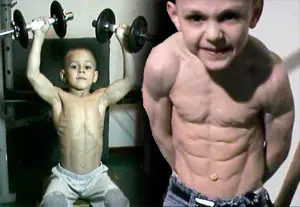As we have said many times before, all ages are submissive to sports. “Iron sport” is no exception to this rule. Just as rapidly as for adults, bodybuilding for children is also gaining popularity. Why not? I suppose it is no secret to anyone these days that modern Champions of athletics and rhythmic gymnastics begin to train their children from the age of 3. After all, to achieve truly real success in these sports, you need to spend decades. And starting classes at the age of 6 is already considered an irreparable lag, doomed to failure...
Of course, no one says that the baby should be immediately placed under a barbell from the cradle and loaded with unbearable weights and Olympic standards! This will definitely be unnecessary, and even harmful to the child’s health. But reasonable, standardized and controlled athletic training, and group training with fun outdoor games, will only have a positive impact on the physical, mental and spiritual state of your baby...
Until recently, the following norms were the acceptable level of sports activity for children:
It is useful for younger schoolchildren to learn how to climb a rope. These exercises are necessary to develop flexibility, dexterity, balance, coordination and softness of movements.
For adolescents over 14 years of age, special gymnastic exercises are recommended:
- I) pull-ups on the bar,
- II) flexion and extension of the arms while lying down,
- III) raising and lowering the body in a lying position (hands behind the head, legs secured).
You can include barbell pushes from the chest into special strength training.
Schoolchildren under 14 years of age should be very careful when engaging in strength exercises; their bodies are not yet ready to experience prolonged physical stress.
Nowadays, the view on children's sports has changed somewhat, and along with it, the norms of permissible load have changed towards an increase... But the question is: is it possible to cultivate bodybuilding for children? Or will this be too much?
Strength exercises with preschool children strengthen their health, promote accelerated growth and development, and develop correct posture. By doing athletic gymnastics, children become cheerful and energetic, resilient and strong, dexterous and fast. They tolerate the load well, but you should always remember that it should increase gradually and consistently, and the effect of exercise on the growing body should remain constant. In this case, it is necessary to clearly take into account age and the degree of physical development (as opposed to unorganized and often monotonous motor activity). The total duration of one lesson is different for each age. For children under two years old it is 8 - 10 minutes, from two to three - up to 15 - 20, for older children - up to 30 - 40. To prevent fatigue, change starting positions (sitting, standing, lying) and movements more often, alternating them with rest breaks. You can use dumbbells, sticks, a ball, clubs, bags with weights, etc. as weights. It is necessary to correctly and clearly explain to the child the procedure for performing the exercise. Exercises with an open window, barefoot, are useful.
Important points in creating a workout for children.
When planning physical training for children and choosing exercises for them, it is important to remember that in children 3–6 years old the spinal column is very sensitive to deforming influences, and skeletal muscles are characterized by poor development of tendons, fascia, and ligaments. By the age of 6, a child, as a rule, has well-developed large muscle groups of the trunk and limbs, but small muscles, mainly the hands, are extremely weak. To train children 6-8 years old, exercises should be chosen in such a way that the load is feasible and affects various muscle groups, first of all, proportionally develops the flexors and extensors of the torso; special attention is paid to the development of the balance function.
When conducting sports fitness training for children, you need to gradually move from relatively simple exercises performed with low amplitude and at a slow pace at 3-4 years of age to more complex ones in coordination, with adjustable amplitude and variable tempo at an older age. Weights during training for children aged 6–8 years are selected extremely carefully and progressively, and at the age of 3–6 years, weights are rather symbolic and are intended mainly to influence the difficult and slowly developed muscles of the arms, especially the flexors of the hand.
Post Views: 194


